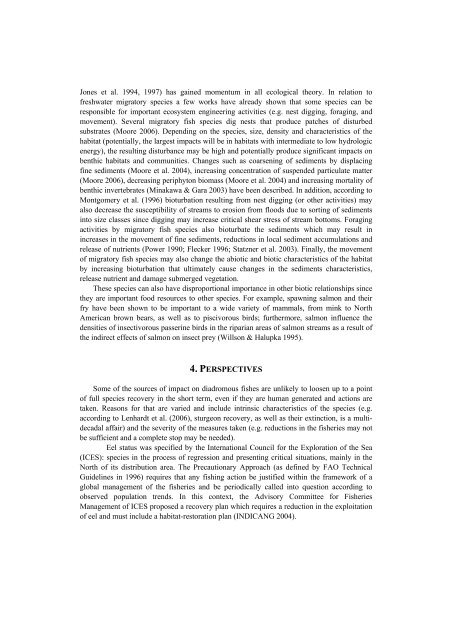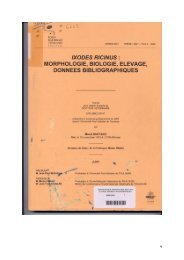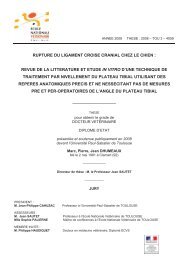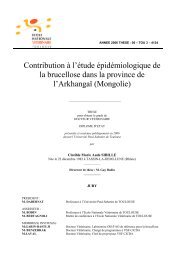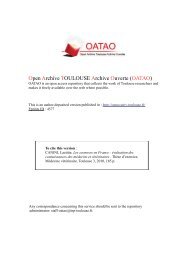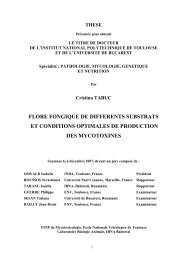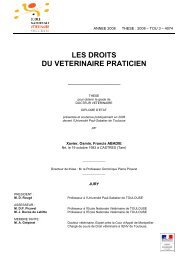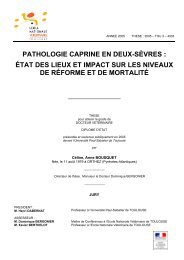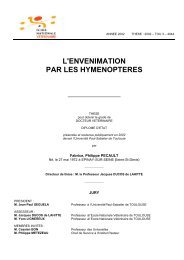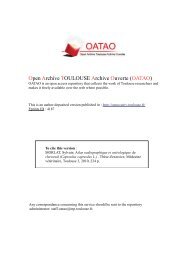PDF ( Author's version) - OATAO (Open Archive Toulouse Archive ...
PDF ( Author's version) - OATAO (Open Archive Toulouse Archive ...
PDF ( Author's version) - OATAO (Open Archive Toulouse Archive ...
You also want an ePaper? Increase the reach of your titles
YUMPU automatically turns print PDFs into web optimized ePapers that Google loves.
Jones et al. 1994, 1997) has gained momentum in all ecological theory. In relation to<br />
freshwater migratory species a few works have already shown that some species can be<br />
responsible for important ecosystem engineering activities (e.g. nest digging, foraging, and<br />
movement). Several migratory fish species dig nests that produce patches of disturbed<br />
substrates (Moore 2006). Depending on the species, size, density and characteristics of the<br />
habitat (potentially, the largest impacts will be in habitats with intermediate to low hydrologic<br />
energy), the resulting disturbance may be high and potentially produce significant impacts on<br />
benthic habitats and communities. Changes such as coarsening of sediments by displacing<br />
fine sediments (Moore et al. 2004), increasing concentration of suspended particulate matter<br />
(Moore 2006), decreasing periphyton biomass (Moore et al. 2004) and increasing mortality of<br />
benthic invertebrates (Minakawa & Gara 2003) have been described. In addition, according to<br />
Montgomery et al. (1996) bioturbation resulting from nest digging (or other activities) may<br />
also decrease the susceptibility of streams to erosion from floods due to sorting of sediments<br />
into size classes since digging may increase critical shear stress of stream bottoms. Foraging<br />
activities by migratory fish species also bioturbate the sediments which may result in<br />
increases in the movement of fine sediments, reductions in local sediment accumulations and<br />
release of nutrients (Power 1990; Flecker 1996; Statzner et al. 2003). Finally, the movement<br />
of migratory fish species may also change the abiotic and biotic characteristics of the habitat<br />
by increasing bioturbation that ultimately cause changes in the sediments characteristics,<br />
release nutrient and damage submerged vegetation.<br />
These species can also have disproportional importance in other biotic relationships since<br />
they are important food resources to other species. For example, spawning salmon and their<br />
fry have been shown to be important to a wide variety of mammals, from mink to North<br />
American brown bears, as well as to piscivorous birds; furthermore, salmon influence the<br />
densities of insectivorous passerine birds in the riparian areas of salmon streams as a result of<br />
the indirect effects of salmon on insect prey (Willson & Halupka 1995).<br />
4. PERSPECTIVES<br />
Some of the sources of impact on diadromous fishes are unlikely to loosen up to a point<br />
of full species recovery in the short term, even if they are human generated and actions are<br />
taken. Reasons for that are varied and include intrinsic characteristics of the species (e.g.<br />
according to Lenhardt et al. (2006), sturgeon recovery, as well as their extinction, is a multidecadal<br />
affair) and the severity of the measures taken (e.g. reductions in the fisheries may not<br />
be sufficient and a complete stop may be needed).<br />
Eel status was specified by the International Council for the Exploration of the Sea<br />
(ICES): species in the process of regression and presenting critical situations, mainly in the<br />
North of its distribution area. The Precautionary Approach (as defined by FAO Technical<br />
Guidelines in 1996) requires that any fishing action be justified within the framework of a<br />
global management of the fisheries and be periodically called into question according to<br />
observed population trends. In this context, the Advisory Committee for Fisheries<br />
Management of ICES proposed a recovery plan which requires a reduction in the exploitation<br />
of eel and must include a habitat-restoration plan (INDICANG 2004).


